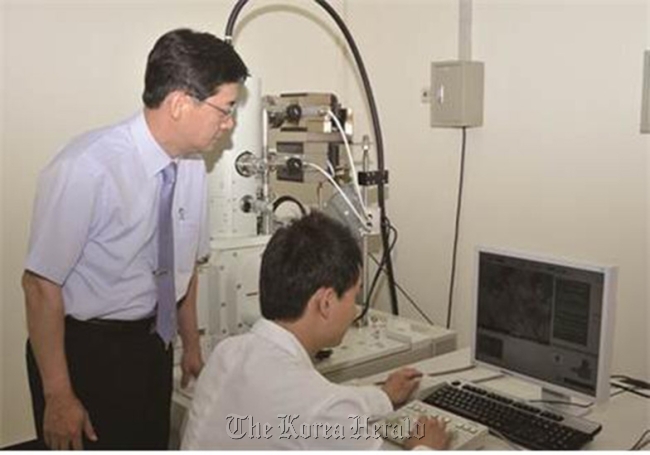New derivatives could be boost to local electronics industry
Korean scientists have developed new organic materials that may help the electronics industry produce next-generation displays and maintain its global competitiveness.
A team of scientists led by professor Choi Dong-hoon of Korea University said it has discovered extended conjugated molecules through compounds of porphyrin.
The porphyrin derivatives may be used to boost the efficiency of semiconducting devices such as organic field-effect transistors for next generation displays, it said.
The organic materials could be applied to the development of flexible displays, transparent displays and foldable displays, or the convergence of all these types of future displays, which, experts said, could replace newspapers and magazines in the near future.
The team found that the materials provide “strong intermolecular interactions, while enhancing the charge-transport efficiency” in organic FETs as well as optoelectronic devices.
Korean scientists have developed new organic materials that may help the electronics industry produce next-generation displays and maintain its global competitiveness.
A team of scientists led by professor Choi Dong-hoon of Korea University said it has discovered extended conjugated molecules through compounds of porphyrin.
The porphyrin derivatives may be used to boost the efficiency of semiconducting devices such as organic field-effect transistors for next generation displays, it said.
The organic materials could be applied to the development of flexible displays, transparent displays and foldable displays, or the convergence of all these types of future displays, which, experts said, could replace newspapers and magazines in the near future.
The team found that the materials provide “strong intermolecular interactions, while enhancing the charge-transport efficiency” in organic FETs as well as optoelectronic devices.

“This high performance of the FETs is mainly due to the very intriguing ... dimeric porphyrin pairs in the crystalline structures,” the team said in its report in the science academic journal Advanced Materials.
“Porphyrins are one of the most important conjugated planar molecules in the field of electronics and optoelectronics, and they have often been employed in organic FETs, organic phototransistors and organic photovoltaics.”
Organic FETs have been thoroughly researched as they are light-weight, simple to produce and smaller than existing silicon-based transistors, which could be an advantage in the development of flexible and transparent displays.
But the downside of porphyrins-based FETs is that they have not yet proven to be stable over the long-term, the team said in a press release via the Ministry of Education, Science and Technology.
“The results obtained in this work demonstrate unambiguously the great potential of metalloporphyrins as candidates for future organic semiconducting materials,” the team said in the journal.
Transistors are key devices of semiconductors, along with capacitors. The former, which functions like a switch, conducts, controls and transports the electric current flowing into capacitors.
Capacitors are then charged with digital numbers of zeros and ones, the only recognized numbers for electronics, by transistors in memory chips, which are made of silicon.
These transistors are also used for the production of displays.
When people view their LCD TVs or computer monitors, they are actually looking at hundreds of transistors formed together on crystal glasses that display sharp pictures through digital codes and optical memories.
Given that the manufacturing processes of chips and displays are very similar, it is common to see a world-renowned chip maker also being a world-renowned display producer, such as Samsung Electronics.
Although LG Electronics does not produce chips (it used to until it had to sell off its chip-making unit), it is able to mass supply displays globally, with panels by its subsidiary LG Display, as Korea is the leading chip producing economy.
This synergistic relationship between chips and displays is what drives the Korean industry to develop faster chips and newer displays, experts said.
Korea’s Ministry of Knowledge Economy has put flexible and transparent displays, organic light-emitting diodes and industrial materials development as the country’s new growth engines. LG Display, which has recently gained spotlight as a Korean company that supplies mobile displays to Apple, is currently working on future display projects with its small- and medium-size partners and universities.
These are in line with efforts to create jobs and maintain Korea’s global competitiveness in displays, which account for more than 50 percent of the world markets as of the first half of 2012.
By Park Hyong-ki (hkp@heraldcorp.com)







![[Graphic News] More Koreans say they plan long-distance trips this year](http://res.heraldm.com/phpwas/restmb_idxmake.php?idx=644&simg=/content/image/2024/04/17/20240417050828_0.gif&u=)
![[KH Explains] Hyundai's full hybrid edge to pay off amid slow transition to pure EVs](http://res.heraldm.com/phpwas/restmb_idxmake.php?idx=644&simg=/content/image/2024/04/18/20240418050645_0.jpg&u=20240419100350)





![[From the Scene] Monks, Buddhists hail return of remains of Buddhas](http://res.heraldm.com/phpwas/restmb_idxmake.php?idx=652&simg=/content/image/2024/04/19/20240419050617_0.jpg&u=20240419175937)

![[KH Explains] Hyundai's full hybrid edge to pay off amid slow transition to pure EVs](http://res.heraldm.com/phpwas/restmb_idxmake.php?idx=652&simg=/content/image/2024/04/18/20240418050645_0.jpg&u=20240419100350)

![[Today’s K-pop] Illit drops debut single remix](http://res.heraldm.com/phpwas/restmb_idxmake.php?idx=642&simg=/content/image/2024/04/19/20240419050612_0.jpg&u=)